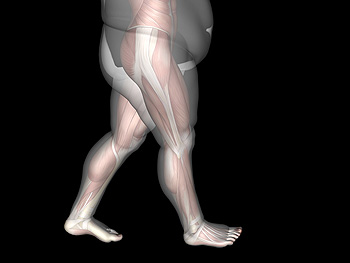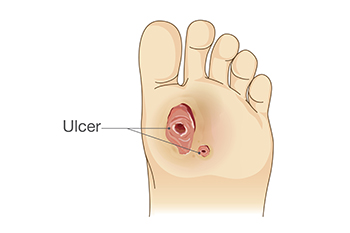Items filtered by date: October 2025
Obesity May Lead to Medical Conditions That Affect the Feet
 Medical conditions that can affect the feet may develop as a result of being obese. These conditions include general foot pain, arthritis, heel pain, diabetes and possible skin complications. Pressure may increase on the ankles and feet, and exercising may become difficult. The feet may become wider, and larger shoes may have to be purchased. Heel pain may develop, which can indicate plantar fasciitis, which is an inflammation of the plantar fascia. This can become painful as the heel endures additional weight on a continuous basis. Diabetes is a common medical ailment which can originate from elevated blood sugar levels. Diabetes can cause nerve damage and alter the body's ability to fight infection. If you would like more information about how to manage foot conditions that can be caused by obesity, please consult with a podiatrist.
Medical conditions that can affect the feet may develop as a result of being obese. These conditions include general foot pain, arthritis, heel pain, diabetes and possible skin complications. Pressure may increase on the ankles and feet, and exercising may become difficult. The feet may become wider, and larger shoes may have to be purchased. Heel pain may develop, which can indicate plantar fasciitis, which is an inflammation of the plantar fascia. This can become painful as the heel endures additional weight on a continuous basis. Diabetes is a common medical ailment which can originate from elevated blood sugar levels. Diabetes can cause nerve damage and alter the body's ability to fight infection. If you would like more information about how to manage foot conditions that can be caused by obesity, please consult with a podiatrist.
Obesity has become very problematic at this point in time and can have extremely negative effects on the feet. If you’re an obese individual and are concerned about your feet, contact Kenneth Williams, DPM from Texas. Our doctor can provide the care you need to keep you pain-free and on your feet.
Obesity and Your Feet
Since your feet are what support your entire weight when standing, any additional weight can result in pain and swelling. Being overweight is one of the main contributors to foot complications.
Problems & Complications
Extra Weight – Even putting on just a few extra pounds could create serious complications for your feet. As your weight increases, your balance and body will shift, creating new stresses on your feet. This uneven weight distribution can cause pain, even while doing the simplest tasks, such as walking.
Diabetes – People who are overweight are at serious risk of developing type-2 diabetes, which has a drastic impact on the health of your feet. As you get older, your diabetes might worsen, which could lead to loss of feeling in your feet, sores, and bruises. You could also become more prone to various infections.
Plantar fasciitis – Pressure and stress that is placed on muscles, joints, and tendons can trigger plantar fasciitis, which is an inflammation of tissue that forms along the bottom of the foot.
If you have any questions, please feel free to contact our office located in San Antonio and Beeville, TX . We offer the newest diagnostic and treatment technologies for all your foot care needs.
Caring for Diabetic Foot Ulcers

A diabetic foot ulcer is an open sore or wound that develops on the foot of a person with diabetes, often caused by poor circulation, nerve damage, or high blood sugar levels. These ulcers can lead to serious infections, if not treated promptly. Proper care includes keeping the wound clean, protecting it from pressure or friction, monitoring for signs of infection, and managing blood sugar levels. Symptoms include redness, swelling, discharge, or persistent pain. A podiatrist can help by evaluating the ulcer, providing specialized wound care, and recommending protective footwear or orthotics. This foot doctor can also develop a treatment plan to promote healing and prevent complications. If you have diabetes and have developed a foot ulcer, it is strongly suggested that you are under the care of a podiatrist who can help you to manage this serious condition.
Wound care is an important part in dealing with diabetes. If you have diabetes and a foot wound or would like more information about wound care for diabetics, consult with Kenneth Williams, DPM from Texas. Our doctor will assess your condition and provide you with quality foot and ankle treatment.
What Is Wound Care?
Wound care is the practice of taking proper care of a wound. This can range from the smallest to the largest of wounds. While everyone can benefit from proper wound care, it is much more important for diabetics. Diabetics often suffer from poor blood circulation which causes wounds to heal much slower than they would in a non-diabetic.
What Is the Importance of Wound Care?
While it may not seem apparent with small ulcers on the foot, for diabetics, any size ulcer can become infected. Diabetics often also suffer from neuropathy, or nerve loss. This means they might not even feel when they have an ulcer on their foot. If the wound becomes severely infected, amputation may be necessary. Therefore, it is of the upmost importance to properly care for any and all foot wounds.
How to Care for Wounds
The best way to care for foot wounds is to prevent them. For diabetics, this means daily inspections of the feet for any signs of abnormalities or ulcers. It is also recommended to see a podiatrist several times a year for a foot inspection. If you do have an ulcer, run the wound under water to clear dirt from the wound; then apply antibiotic ointment to the wound and cover with a bandage. Bandages should be changed daily and keeping pressure off the wound is smart. It is advised to see a podiatrist, who can keep an eye on it.
If you have any questions please contact our office located in San Antonio and Beeville, TX . We offer the newest diagnostic and treatment technologies for all your foot and ankle needs.
Why Live with Pain and Numbness in Your Feet?
What Can Cause an Ankle Sprain in Volleyball?

A sprained ankle is one of the most frequent injuries in volleyball and happens when the ligaments that support the ankle are stretched or torn. Quick movements, jumping, spiking, or blocking often lead to awkward landings that place excess force on the joint. Sprains are classified by degrees of severity. A mild sprain, or first degree, involves slight stretching with minor pain and swelling. A moderate sprain, or second degree, includes partial tearing with noticeable bruising and difficulty walking. A severe sprain, also known as third degree, involves complete ligament tearing, significant swelling, and instability. A podiatrist can assess the degree of injury, provide treatment, and create a rehabilitation plan to restore strength and prevent re-injury. If you have sprained your ankle while playing volleyball, it is suggested that you promptly contact a podiatrist who can begin the appropriate treatment for recovery.
Ankle and foot injuries are common among athletes and in many sports. They can be caused by several problems and may be potentially serious. If you are feeling pain or think you were injured in a sporting event or when exercising, consult with Kenneth Williams, DPM from Texas. Our doctor will assess your condition and provide you with quality foot and ankle treatment.
Common Injuries
The most common injuries that occur in sporting activities include:
- Achilles Tendonitis
- Achilles Tendon Rupture
- Ankle Sprains
- Broken Foot
- Plantar Fasciitis
- Stress Fractures
- Turf Toe
Symptoms
Symptoms vary depending upon the injury and in some cases, there may be no symptoms at all. However, in most cases, some form of symptom is experienced. Pain, aching, burning, bruising, tenderness, tightness or stiffness, sensation loss, difficulty moving, and swelling are the most common symptoms.
Treatment
Just as symptoms vary depending upon the injury, so do treatment options. A common treatment method is known as the RICE method. This method involves rest, applying ice, compression and elevating the afflicted foot or ankle. If the injury appears to be more serious, surgery might be required, such as arthroscopic or reconstructive surgery. Lastly, rehabilitation or therapy might be needed to gain full functionality in the afflicted area. Any discomfort experienced by an athlete must be evaluated by a licensed, reputable medical professional.
If you have any questions please contact our office located in San Antonio and Beeville, TX . We offer the newest diagnostic and treatment technologies for all your foot and ankle needs.
Treatment Options for Broken Toes

Broken toes can cause significant discomfort and limit mobility. Toe fractures usually occur from stubbing the toe, dropping something heavy on the foot, or sustaining a sports-related impact. Symptoms include swelling, bruising, and pain when walking or applying pressure. Diagnosis is confirmed through an exam and imaging to assess the extent of the fracture and determine if the bone is displaced. Stable, nondisplaced fractures may be managed with protective footwear to reduce movement and pressure, while displaced fractures often require a procedure to realign the bone. Fractures of the big toe tend to be more serious due to this toe’s role in balance and walking. Big toe injuries may require stabilization or even surgery if the damage is severe. A podiatrist can provide a proper diagnosis, realignment, and supportive devices to promote healing and prevent long-term complications. If you are experiencing pain from a broken toe, it is suggested that you make an appointment with a podiatrist for an exam, diagnosis, and treatment.
A broken toe can be very painful and lead to complications if not properly fixed. If you have any concerns about your feet, contact Kenneth Williams, DPM from Texas. Our doctor will treat your foot and ankle needs.
What to Know About a Broken Toe
Although most people try to avoid foot trauma such as banging, stubbing, or dropping heavy objects on their feet, the unfortunate fact is that it is a common occurrence. Given the fact that toes are positioned in front of the feet, they typically sustain the brunt of such trauma. When trauma occurs to a toe, the result can be a painful break (fracture).
Symptoms of a Broken Toe
- Throbbing pain
- Swelling
- Bruising on the skin and toenail
- The inability to move the toe
- Toe appears crooked or disfigured
- Tingling or numbness in the toe
Generally, it is best to stay off of the injured toe with the affected foot elevated.
Severe toe fractures may be treated with a splint, cast, and in some cases, minor surgery. Due to its position and the pressure it endures with daily activity, future complications can occur if the big toe is not properly treated.
If you have any questions, please feel free to contact our office located in San Antonio and Beeville, TX . We offer the newest diagnostic and treatment technologies for all your foot care needs.

